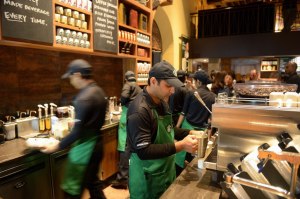Over the past few weeks I have been meeting with a number of supply chain services companies who are talking about and focusing on developing solutions that will allow users to be laser focused with demand sensing and shaping. This was particularly evident during my meetings at NRF in New York. We also have the likes of eCommerce giant Amazon who have patented technology that claims to be able to put on the truck the product you have yet to order because they know that you will order it! All very interesting and exciting for supply chains – these supply chains strive to eliminate or at least control the lumpiness associated with their demand patterns.
However this begets a question – is this necessarily good? For example. The situation I hear often is what takes place at Starbucks. A regular client walks into their local Starbucks, the barista notices them standing in line and knows their preferred order. The customer reaches the cash register and their usual venti, skinny, vanilla latte is already waiting for them. All they have to do is pay and pick up their piping hot coffee. Sounds lovely.
And for the most part maybe that customer appreciates the convenience, and feeling of being so well known that you are the “mayor” of that Starbucks. But what if that customer does not want that skinny vanilla latte? What if the customer wants a hot chocolate one day? Do they dare deviate from their usual order or do they accept the usual order for the convenience?
The same holds true for grocers such as Stop and Shop or Walmart, who let you order online and pick up in store – and will predict what your basket will look like. So all you need to do is drive to the grocery store and pick up your order. There is no need to think too much. Of course the positive is that there are tremendous time savings for the customer if they do not want to contemplate a new mix of groceries. But what if the consumer wants to try a new cheese or kitchen cleaner? If their order is already compiled for them will they get the opportunity to see what else is available? Or do we not want to give them the opportunity? How do we make sure they have the opportunity to browse?
My point is not that supply chain users and vendors should not stop striving to get too smart and more effective when it comes to demand shaping and sensing. However there must be some balance when it comes to how precise and “effective” the supply chains need and want to be with regards to the customer. Yes, we want to eliminate lumpiness and extract those savings from the supply chain. But retailers and other players in the supply chains need to still keep a balance with being very precise with how they manipulate and predict demand with the opportunity for their customers to deviate from their usual demand. Retailers and other customer focused industries need to determine how precise they want to be with their demand shaping and how much freedom they want to give their customers to roam and wander through options.
![]()



